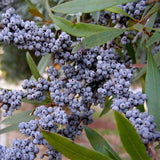Myrica pensylvanica d.b. (with Wax) (Bayberry)
Myrica pensylvanica d.b. (Bayberry) is a species of shrub native to eastern North America, including parts of Canada and the United States. It is a member of the Myricaceae family and is closely related to Myrica cerifera (Southern Waxmyrtle).
Appearance: Bayberry is a deciduous shrub that typically grows to a height of 3 to 10 feet (1 to 3 meters), although it can occasionally reach up to 15 feet (4.5 meters). The shrub has a dense, rounded habit with multiple stems arising from the base. The leaves are alternate, simple, and leathery, measuring about 1 to 3 inches (2.5 to 7.5 cm) in length. They are oblong or elliptical in shape and have a glossy, dark green color.
Bark: The bark of Bayberry is smooth and grayish-brown when young, but it becomes rough and scaly as the shrub matures.
Flowers: The species is dioecious, meaning that male and female flowers are borne on separate plants. The flowers are small, yellow-green, and appear in dense, cylindrical spikes called catkins. The male catkins are longer and more conspicuous than the female catkins. Flowering typically occurs in late spring or early summer.
Fruits: Female Bayberry plants produce small, waxy berries that are grayish-white or bluish-gray in color. The berries are covered with a thick layer of waxy coating, giving them a unique appearance and texture. These berries persist on the shrub through the winter, providing a valuable food source for birds.
Ecological significance: Bayberry shrubs have ecological importance, particularly for birds. The waxy berries are a high-energy food source that many bird species rely on during the winter months when other food is scarce. The shrubs also provide nesting sites and cover for birds and other wildlife. Additionally, Bayberry is a host plant for the larvae of certain butterfly species.
Uses: Bayberry has been historically used for various purposes. The waxy coating on the berries, known as bayberry wax, has been used in candle-making, as it has a pleasant scent and can produce a natural, aromatic wax. The leaves and twigs of the shrub have also been used in traditional medicine for their astringent and antiseptic properties.
It's worth noting that while Myrica pensylvanica is generally considered safe and non-toxic, the berries should not be consumed in large quantities as they may cause stomach upset.
Botanical Name : Myrica pensylvanica d.b.
Common Name : Bayberry
Height : 5- 10 ft
Spread : 5 ft
Germination Info : Seed requires 90 days cold moist stratification
Hardiness zone : 3-7
Other info : D.B. (Dried Berries)
Average seed per ounce : Approx. 750











